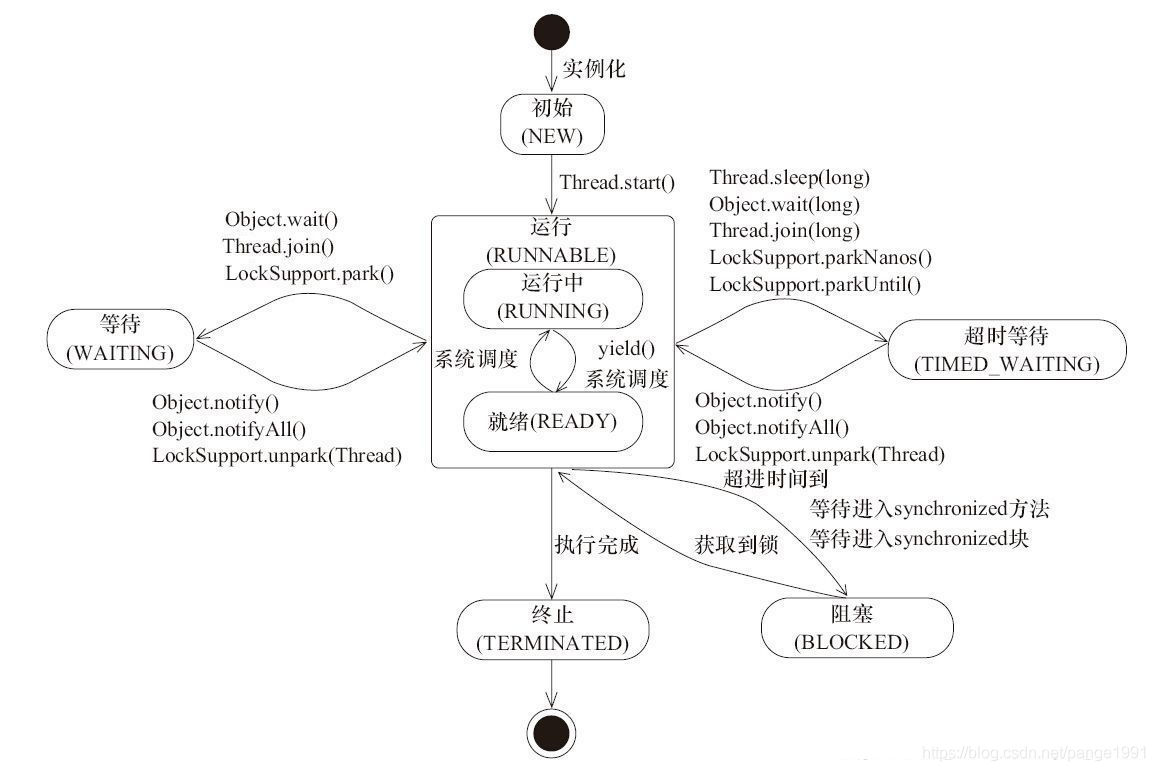多线程-2.线程创建方式和Thread类
1 class PrimeThread extends Thread {
2 long minPrime;
3 PrimeThread(long minPrime) {
4 this.minPrime = minPrime;
5 }
6
7 public void run() {
8 // compute primes larger than minPrime
9 . . .
10 }
11 }
12 PrimeThread p = new PrimeThread(143);
13 p.start();
1 class PrimeRun implements Runnable {
2 long minPrime;
3 PrimeRun(long minPrime) {
4 this.minPrime = minPrime;
5 }
6
7 public void run() {
8 // compute primes larger than minPrime
9 . . .
10 }
11 }
12 PrimeRun p = new PrimeRun(143);
13 new Thread(p).start();

private volatile int threadStatus = 0;
public State getState() {
// get current thread state
return sun.misc.VM.toThreadState(threadStatus);
}
public static State toThreadState(int var0) {
if ((var0 & 4) != 0) {
return State.RUNNABLE;
} else if ((var0 & 1024) != 0) {
return State.BLOCKED;
} else if ((var0 & 16) != 0) {
return State.WAITING;
} else if ((var0 & 32) != 0) {
return State.TIMED_WAITING;
} else if ((var0 & 2) != 0) {
return State.TERMINATED;
} else {
return (var0 & 1) == 0 ? State.NEW : State.RUNNABLE;
}
}
public enum State {
/**
* Thread state for a thread which has not yet started.
*/
NEW,
/**
* Thread state for a runnable thread. A thread in the runnable
* state is executing in the Java virtual machine but it may
* be waiting for other resources from the operating system
* such as processor.
*/
RUNNABLE,
/**
* Thread state for a thread blocked waiting for a monitor lock.
* A thread in the blocked state is waiting for a monitor lock
* to enter a synchronized block/method or
* reenter a synchronized block/method after calling
* {@link Object#wait() Object.wait}.
*/
BLOCKED,
/**
* Thread state for a waiting thread.
* A thread is in the waiting state due to calling one of the
* following methods:
* <ul>
* <li>{@link Object#wait() Object.wait} with no timeout</li>
* <li>{@link #join() Thread.join} with no timeout</li>
* <li>{@link LockSupport#park() LockSupport.park}</li>
* </ul>
*
* <p>A thread in the waiting state is waiting for another thread to
* perform a particular action.
*
* For example, a thread that has called <tt>Object.wait()</tt>
* on an object is waiting for another thread to call
* <tt>Object.notify()</tt> or <tt>Object.notifyAll()</tt> on
* that object. A thread that has called <tt>Thread.join()</tt>
* is waiting for a specified thread to terminate.
*/
WAITING,
/**
* Thread state for a waiting thread with a specified waiting time.
* A thread is in the timed waiting state due to calling one of
* the following methods with a specified positive waiting time:
* <ul>
* <li>{@link #sleep Thread.sleep}</li>
* <li>{@link Object#wait(long) Object.wait} with timeout</li>
* <li>{@link #join(long) Thread.join} with timeout</li>
* <li>{@link LockSupport#parkNanos LockSupport.parkNanos}</li>
* <li>{@link LockSupport#parkUntil LockSupport.parkUntil}</li>
* </ul>
*/
TIMED_WAITING,
/**
* Thread state for a terminated thread.
* The thread has completed execution.
*/
TERMINATED;
}
1 public synchronized void start() {
2 // 如果线程不是"就绪状态",则抛出异常!
3 if (threadStatus != 0)
4 throw new IllegalThreadStateException();
5 // 将线程添加到ThreadGroup中
6 group.add(this);
7 boolean started = false;
8 try {
9 // 通过start0()启动线程,新线程会调用run()方法
10 start0();
11 // 设置started标记=true
12 started = true;
13 } finally {
14 try {
15 if (!started) {
16 group.threadStartFailed(this);
17 }
18 } catch (Throwable ignore) {
19 }
20 }
21 }
1 public void run() {
2 if (target != null) {
3 target.run();
4 }
5 }
1 //简单起见,使用匿名内部类的方法来创建线程
2 Thread thread = new Thread(){
3 @Override
4 public void run() {
5 System.out.println("Thread对象的run方法被执行了");
6 }
7 };
8 //线程启动
9 thread.start();
10
11 //用循环去监听线程thread是否还活着,只有当线程thread已经结束了,才跳出循环
12 while(thread.isAlive()){}
13 //线程thread结束了,但仍能调用thread对象的大部分方法
14 System.out.println("线程"+thread.getName()+"的状态:"+thread.getState()+"---优先级:"+thread.getPriority());
15 //调用run方法
16 thread.run();
17 //当线程结束时,start方法不能调用,下面的方法将会抛出异常
18 thread.start();
多线程-2.线程创建方式和Thread类的更多相关文章
- 【多线程】线程创建方式三:实现callable接口
线程创建方式三:实现callable接口 代码示例: import org.apache.commons.io.FileUtils; import java.io.File; import java. ...
- python 多线程编程之threading模块(Thread类)创建线程的三种方法
摘录 python核心编程 上节介绍的thread模块,是不支持守护线程的.当主线程退出的时候,所有的子线程都将终止,不管他们是否仍在工作. 本节开始,我们开始介绍python的另外多线程模块thre ...
- JAVA与多线程开发(线程基础、继承Thread类来定义自己的线程、实现Runnable接口来解决单继承局限性、控制多线程程并发)
实现线程并发有两种方式:1)继承Thread类:2)实现Runnable接口. 线程基础 1)程序.进程.线程:并行.并发. 2)线程生命周期:创建状态(new一个线程对象).就绪状态(调用该对象的s ...
- Java多线程学习(二)---线程创建方式
线程创建方式 摘要: 1. 通过继承Thread类来创建并启动多线程的方式 2. 通过实现Runnable接口来创建并启动线程的方式 3. 通过实现Callable接口来创建并启动线程的方式 4. 总 ...
- Java实现线程的两种方式?Thread类实现了Runnable接口吗?
Thread类实现了Runnable接口吗? 我们看看源码中对与Thread类的部分声明 public class Thread implements Runnable { /* Make sure ...
- Java基础加强之多线程篇(线程创建与终止、互斥、通信、本地变量)
线程创建与终止 线程创建 Thread类与Runnable接口的关系 public interface Runnable { public abstract void run(); } public ...
- Java基础之多线程篇(线程创建与终止、互斥、通信、本地变量)
线程创建与终止 线程创建 Thread类与Runnable接口的关系 public interface Runnable { public abstract void run(); } public ...
- Java:多线程概述与创建方式
目录 Java:多线程概述与创建方式 进程和线程 并发与并行 多线程的优势 线程的创建和启动 继承Thread类 start()和run() 实现Runnable接口 实现Callable接口 创建方 ...
- java多线程(一)-五种线程创建方式
简单使用示例 Java 提供了三种创建线程的方法: 通过实现 Runnable 接口: 通过继承 Thread 类本身: 通过 Callable 和 Future 创建线程. 还有 定时器 线程池 下 ...
随机推荐
- AES加密--适用于RC2、RC4和Blowfish
package test; import java.security.GeneralSecurityException; import java.security.Key; import javax. ...
- 绿色物流-智慧仓储监控管理 3D 可视化系统
前言 随着电子商务产业的迅速发展,快递爆仓已成为了困扰仓储物流的一大难题.大量的碎片化订单,传统仓储管理和运作方式已无法满足,加速仓储物流管理的智能化.自动化升级创新,延伸而出的智慧物流概念成为物流行 ...
- 15款NOSQL数据库
1.MongoDB 介绍 MongoDB是一个基于分布式文件存储的数据库.由C++语言编写.主要解决的是海量数据的访问效率问题,为WEB应用提供可扩展的高性能数据存储解决方案.当数据量达到50GB以上 ...
- 攻防世界 reverse Newbie_calculations
Newbie_calculations Hack-you-2014 题目名百度翻译成新手计算,那我猜应该是个实现计算器的题目.... IDA打开程序,发现一长串的函数反复调用,而且程序没有输入,只有输 ...
- 1、Spring教程之Spring概述
1.Spring概述 简介 Spring : 春天 --->给软件行业带来了春天 2002年,Rod Jahnson首次推出了Spring框架雏形interface21框架. 2004年3月24 ...
- 前端常见的请求数据汇总(GET POST)
前端在请求接口的时候要和后端人员配合好,根据后端提供的接口文档来进行开发,一般请求类型有这几种 1.GET请求 GET请求一般会将数据放到URL后 GET请求对所发信息量的限制是2000个字符 GET ...
- 最短路径(Dijskra算法)
声明:图片及内容基于:https://www.bilibili.com/video/BV16C4y1H7Zc?from=articleDetail 最短路径 Dijkstra算法 原理 数据结构 核心 ...
- 「HTML+CSS」--自定义加载动画【010】
前言 Hello!小伙伴! 首先非常感谢您阅读海轰的文章,倘若文中有错误的地方,欢迎您指出- 哈哈 自我介绍一下 昵称:海轰 标签:程序猿一只|C++选手|学生 简介:因C语言结识编程,随后转入计算机 ...
- 201871030139-于泽浩 实验二 个人项目D{0-1} KP
201871030139-于泽浩 实验二 个人项目D{0-1} KP 项目 内容 课程班级博客连接 2018级卓越班 这个作业要求连接 软件工程个人项目 我的课程学习目标 (1)掌握软件项目个人开发流 ...
- 四单元总结&OO总结
目录 本单元架构总结 第一次作业 第二次作业 第三次作业 架构设计总结 第一单元 第二单元 第三单元 对测试演进 课程收获 改进建议 线上学习体验 本单元架构总结 第一次作业 第一次作业按照UML正常 ...
